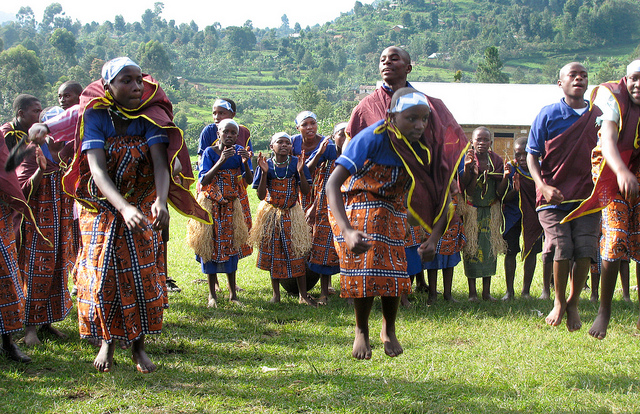
The Bakiga inhabit Kabale and part of Rukungiri districts. They occupy the counties of Ndorwa, Rubanda, Rukigain Kabale and parts of Kinkizi and Rubando counties in Rukungiri districts. Due to overpopulation, the Bakiga have been migrating to other parts of Uganda especially t Kabarole, Rukungiri, Kasese, Hoima, Masindi and Mubende districts; and Rwampara, Ruhuma and Ibanda counties of Mbarara district. They have also settled in Masaka and Rakai districts. They are a physically strong people. They speak Rukiga, a Bantu language.
Origins
The actual origins of the Bakiga are hidden in varying traditions. Some say that the Bakiga originally lived in Karagwe having migrated from Bunyoro during the Luo Invasion. They are associated with the Banyambo of Tanzania. Another tradition which seems more sensible says that the cradle of the Bakiga was in Buganza in Rwanda. They migrated from Buganza in search of fertile land and to escape natural harzards due to internal political conflicts.
From Rwanda, the Bakiga are said to have migrated to Bwisa, to Bugoyi, then to Rutchru, all in Zaire, and they finally settled in Kigezi. Since the Bakiga are Bantu speakers, this tradition could be true. What may equally be true id that the Bakiga were part of the Bantu speakers who migrated from the Congo region, through Bunyoro, Karagwe, Rwanda and eastern Zaire to finally settle in Kigezi. What has not yet been established are the exact dates when they settled in each of the areas en route to Kigezi.
Social set-up
The Bakiga were organized into clans the biggest of which was Basiga clan. Each clan was composed if several lineages and each lineage had ahead, Omukuru w’omuryango. A man was not allowed to marry from his clan.
Marriage
Marriage was a very important cultural institution among the Bakiga. Traditionally, no marriage could be honored without the payment of bride wealth. In the past, a marriage could be arranged by the boy’s father or uncle on the boy’s behalf. The final arrangements could only be made after the payment of bride wealth. The bride was normally paid by the boy’s father. It involved cows, goats and hoes. The amount paid differed from group to group and from family to family within each group. It is said that it was taboo to sell any animals given as bridewealth.Such animals could be used to obtain wives for the girl’s brothers or father.
The Bakiga are a very polygamous society; the number of wives was only limited by the availability of land and bride wealth obligations.
The Bride wealth paid on a girl was shared among the girl’s principal relatives. Of the relatives the most important were Nyinarimi (maternal uncle) and ishenkazi (paternal aunt). If one of them went away dissatisfied, so they said, he could render the girl barren or cause her to have incessant ill- health by inciting the wrath of the ancestors.
Boys tended to marry at a slightly late age, between eighteen and twenty years, while girls could be marred off between fourteen and sixteen years of age. The normal trend was for girls from richer families to get married later than girls from poorer families. Before marriage, a girl wield spend a month or so in seclusion. During this period, she would be well fed and instructed in the art of home management.
Divorce
Divorce was a common phenomenon among the Bakiga. The common causes were barrenness and laziness on the part of the wife or the husband. Some other matters of misunderstanding between a husband and a wife could also lead to divorce. A divorce was allowed to remarry but she would fetch less bride wealth this time as she would no longer be a virgin. The majority of the would-be instances of divorce were settled by the elders. They would normally be called by the woman’s father to listen to both the husband and the wife and try to have the two sides reach an amicable conclusion that would prevent divorce. In such cases, it was normal to fine the offending party. Fighting in the home between husbands and wives was frequent, but would not normally lead to divorce.
Religion
The Bakiga believed in a supreme being Ruhanga, the Creator of all things earthly and heavenly. At a lower level they believed in the cult of Nyabingi. The Nyabingi cult was said to have originated from Karagwe. It had its base at Kagarama, near Lake Bunyonyi. There were special shrines for Nyabingi known as endaro. Through Nyamingi’s representatives known as Abagirwa people would worship and tender sacrifices of beer and roasted meat to Nyamingi.
Economy
The Bakiga were basically agriculturalists growing mainly sorgum, peas, millet, and beans. They also reared some cattle, sheep and goats. Among them were excellent iron- smiths who made hoes, knives, and spears. They were great porters and produced a wide assortment of pottery. Besides, they made a wide range of carpentry object baskets and mats and they reared bees and produce honey.
The Bakiga lived and worked communally. Most economic activities were dome on a communal basis. Grazing, bush clearing, cultivation and harvesting were done communally. The men cleared the bush while the women tiled the land. Men worked together to erect round, grass-thatched huts for shelter. They practiced barter trade amongst themselves and between their neighbors.
The stable foods of Bakiga were sorghum, beans and peas. They supplemented them with pumpkins, yams, meat and a variety of green vegetables.Sufficent food was prepared so that every one could ear his fill. It was considered goof manners to join in whenever one found a given family at a meal. One would just wash one’s hands and join the others without waiting to be invited. If a man had more than one wife, all his women had to serve him at each meal. He could ear the most delicious share of the food among the lot, or all of it if he so wished.
The Bakiga made beer, omuramba, played a significant social role. It had a food component and was an alcoholic drink necessary for social gatherings.Omuramba was normally taken from a pot placed in a convenient place. The men would sit on wooden stools surrounding it and by means of long tubes; they would drink as they discussed matters affecting their country. The elders would also settle disputes, recite their heroic deeds and their history, and sing and dance around a pot of omuramba.
The Bakiga were and still are very good zither (enanga) players. They played it alone or in groups.
Utensils
The Bakiga‘s domestic utensils included baskets, pots, wnnowingtrays, stools, grindingstones, woodenpestles, mortars and mingling ladles. The other household items were drums and harps for entertainment; spears, bows and arrows for defense and hunting; grassmats (ebirago) for sleeping on and emishambi for sitting on. Previously the Bakiga women dressed in cow hides known as ebisahto or enkanda. They wore bangles on their legs and arms.
Political set-up
The Bakiga were a segmentary society. Political authority rested in the hands of lineage leaders, Abakuru b’emiryango, many of whom had excellent oratory as well as military skills. They were supposed to be impartial in administering justice. Some leaders such as Basubi emerged to prominence because they had mystical skills. They were rain makers. Others were Baigirwa, the mediums of Nyabingi cult.
The Bakiga were warlike. They resisted the Batutsi and Bahima incursions. As a politically segmented society, they did not have a standing army. However, they had warlords who would mobilize and lead the people to war in the event of invasion. The warlords were men who had killed a large number of enemies in wars without losing any of their men or weapons. Every able-bodied male was culturally obliged to be a soldier.
Judicial systems.
The Bakiga abhorred anti-social activities and if any one was caught he was heavily punished. Such activities included stealing, blocking paths, murder, sorcery and night dancing. In the case of murder for example, the murderer was buried alive in the same grave with the victim. Virginity was highly esteemed and it was a very serous offence for a girl to get pregnant before marriage. If an unmarried girl became pregnant, she would either be taken to a forest and tied to a tree feet and arms and town over a cliff. Most pregnant girls among the Bakiga were taken to the Kisizi falls in Ndorwa and thrown down the cliff. They would drown in the falls. The lucky ones were simply cursed and disowned by their people.

 Posted in
Posted in 

